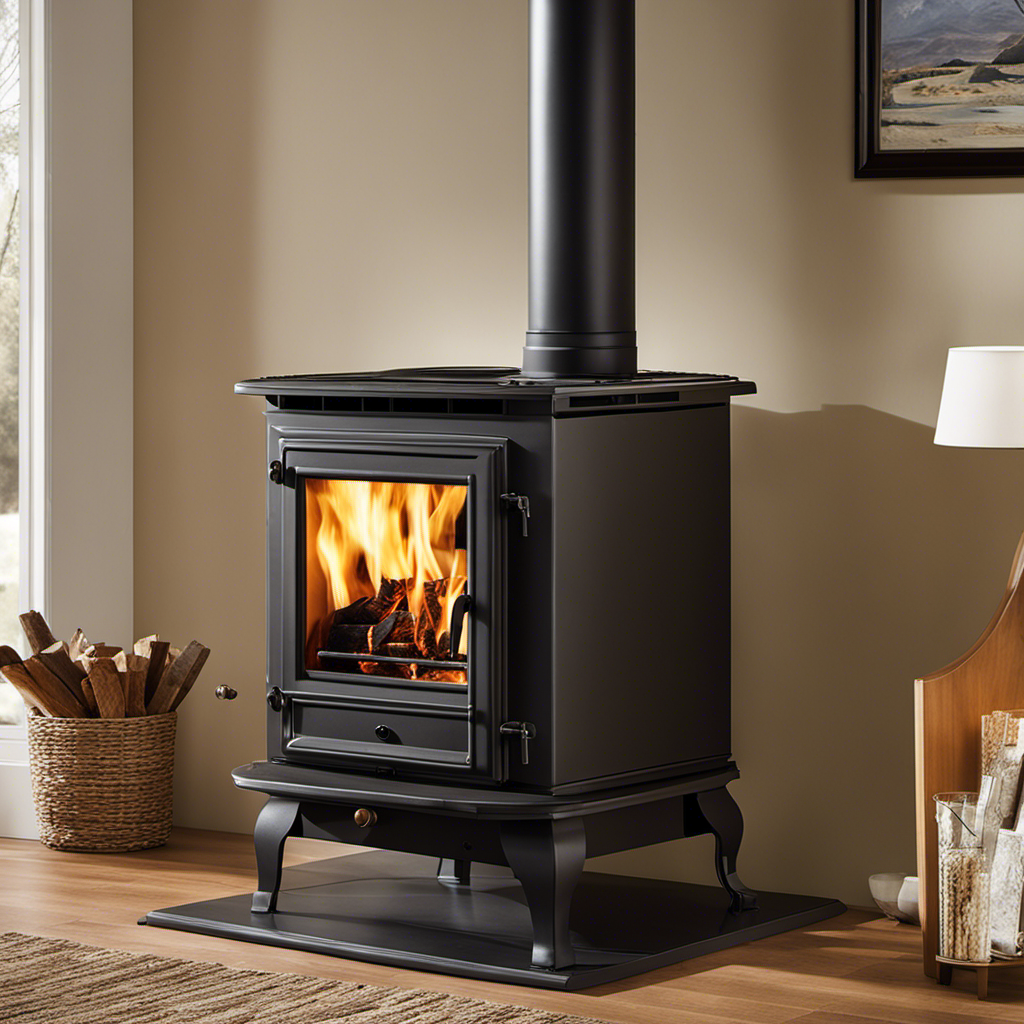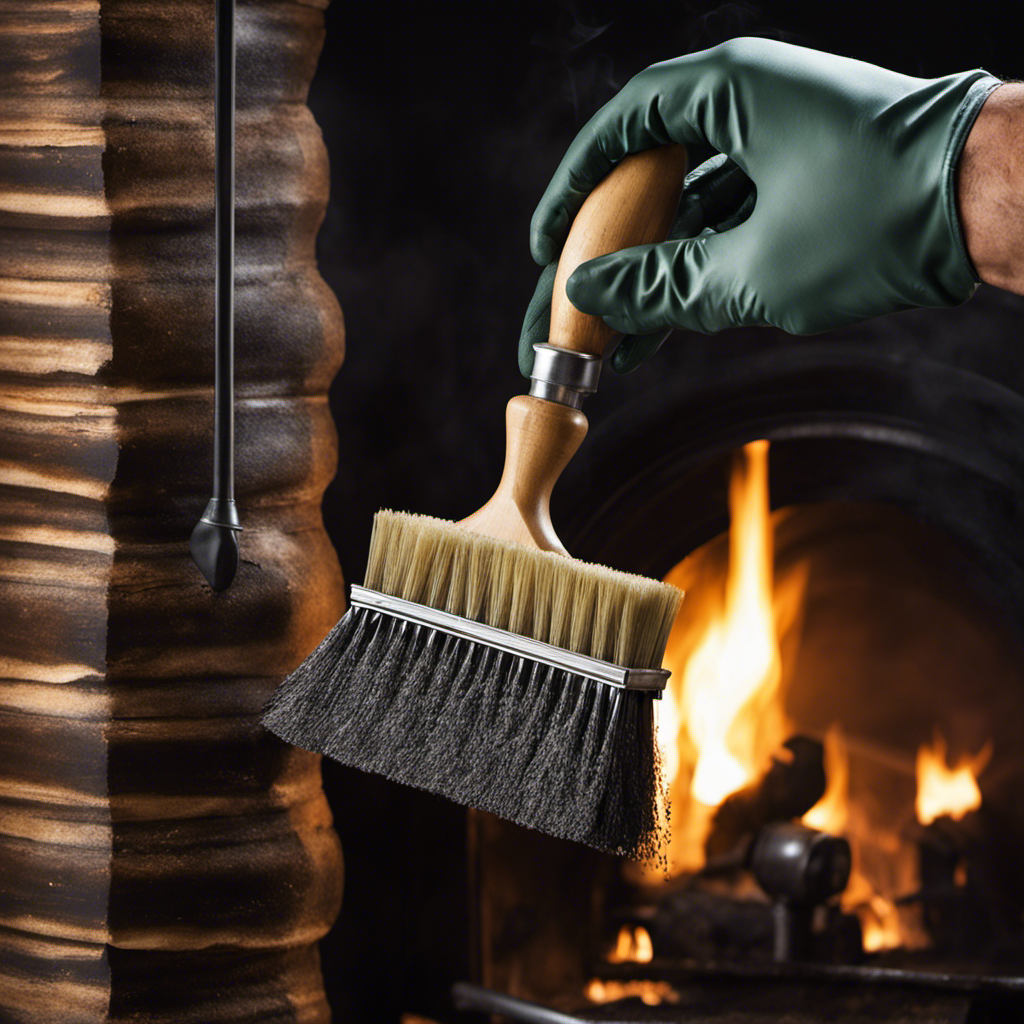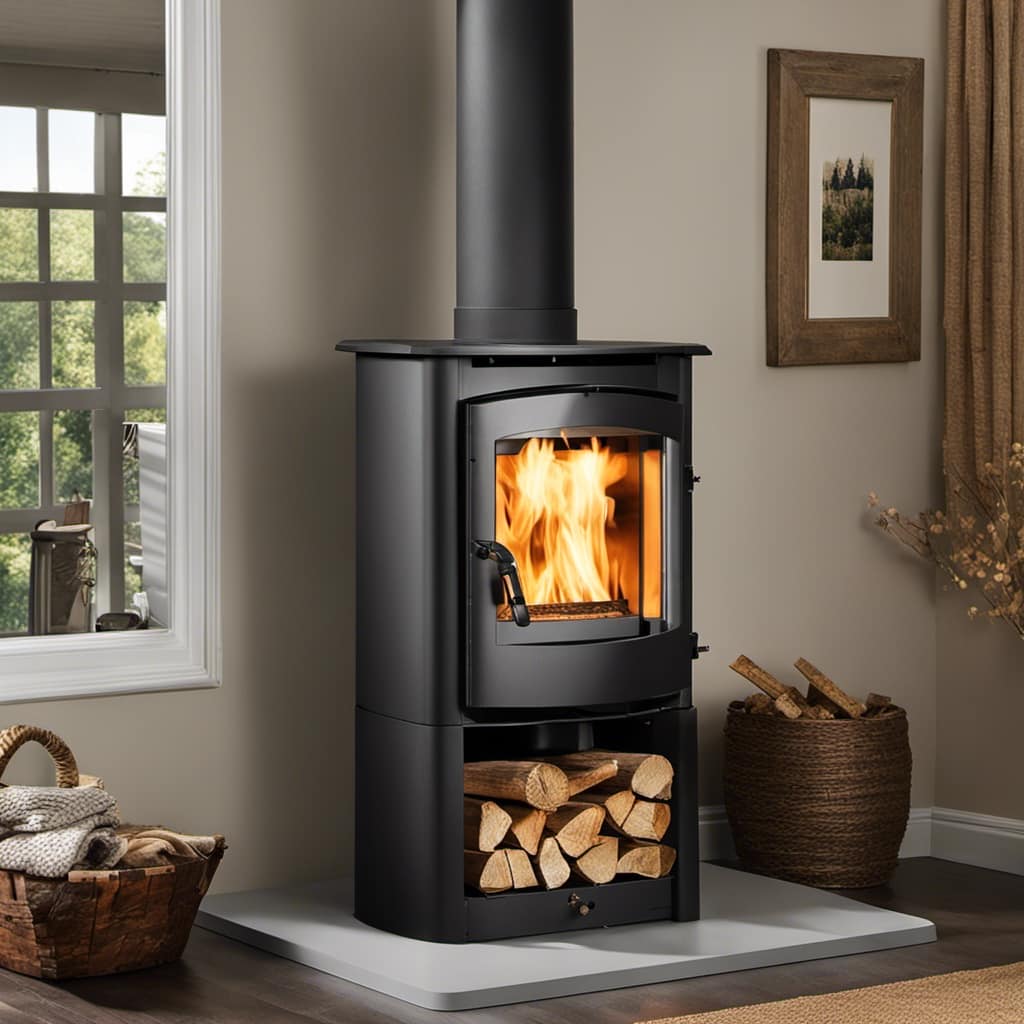You may think maintaining a wood stove is a daunting task. But fear not! We are here to help you through the essential steps to make sure your wood stove operates efficiently and securely.
From regular cleaning and inspections to using the right wood and ensuring proper ventilation, we’ve got you covered.
With these tips, you’ll enjoy the warmth and coziness of your wood stove while ensuring its longevity and safety.
Let’s get started!
Key Takeaways
- Regular cleaning and inspections are essential to prevent creosote build-up and ensure safety and longevity of the wood stove.
- Proper wood selection, storage, and moisture content significantly impact the performance and efficiency of the stove.
- Regular service and ash removal are necessary for safe and efficient operation of the wood stove.
- Following safety precautions, such as installing detectors, keeping flammable materials away, and regularly inspecting and cleaning the stove and chimney, is crucial to maintain the safety and efficiency of the wood stove.
Importance of Cleaning
We need to prioritize cleaning regularly to ensure the safety and efficiency of our wood stove. Cleaning frequency is crucial in preventing the build-up of creosote, a highly flammable substance that can lead to chimney fires. It’s recommended to clean the stovepipe and chimney at least once a year, or more frequently if you use your wood stove extensively.
To effectively clean the stove, you’ll need a few essential tools. A chimney brush with sturdy bristles is necessary for removing creosote deposits. A ash vacuum or a metal ash shovel can be used to remove ashes from the stove. Additionally, a wire brush and a damp cloth can be used to clean the exterior of the stove.
Regular cleaning not only ensures the safety of your wood stove but also improves its efficiency by promoting better air circulation.
Transitioning to regular inspections for longevity and safety, let’s explore the next step.
Regular Inspections for Longevity and Safety
Let’s make sure to schedule regular inspections to ensure the longevity and safety of our wood stove. Regular maintenance and professional inspections are crucial in keeping our wood stove operating safely and efficiently. By conducting regular inspections, we can identify and address any potential issues before they become major problems. This not only ensures the safety of our home but also increases the lifespan of our wood stove.
To give you a better understanding, let’s take a look at the table below:
| Maintenance Task | Frequency | Description |
|---|---|---|
| Clean the chimney | Annually | Removes creosote buildup and prevents chimney fires |
| Check gaskets and seals | Annually | Ensures a tight seal for efficient burning |
| Inspect stove pipes | Annually | Identifies any cracks or leaks |
| Clean the firebox | Monthly | Removes ashes and debris for optimal combustion |
Safe Use and Necessary Repairs
Regular and timely inspections are necessary to ensure the safe use and necessary repairs of our wood stove. It’s crucial to maintain the functionality and efficiency of our wood stove to avoid potential safety hazards. Here are some essential steps to consider:
- Clean the stove regularly: Remove ashes and debris to prevent airflow obstruction and potential fire hazards.
- Inspect the chimney: Regularly check for creosote buildup, blockages, or any signs of damage that may affect proper ventilation.
- Check gaskets and seals: Ensure that gaskets and seals are intact to prevent air leakage and maintain optimal combustion.
- Monitor the flue: Regularly inspect the flue for any cracks or damage that may affect the safe use of the wood stove.
- Test the safety features: Check the functionality of the safety features, such as the door latch and damper, to ensure they’re working correctly.
By following these steps, we can ensure the safe use and necessary repairs of our wood stove.
Now, let’s discuss the importance of using the correct wood for efficiency.
Using Correct Wood for Efficiency
When it comes to using a wood stove efficiently, selecting the correct type of wood is crucial. Proper wood selection can greatly impact the stove’s performance and overall efficiency.
Proper Wood Selection
As we discuss proper wood selection, it’s important to remember that using the correct type of wood ensures efficiency in operating a wood stove. When it comes to choosing the right wood, there are two key factors to consider: wood storage and moisture content.
Wood Storage:
- Keep wood stored in a dry and well-ventilated area.
- Elevate the woodpile off the ground to prevent moisture absorption.
Moisture Content:
- Optimal moisture content for burning is around 20%.
- Use a moisture meter to check the wood’s moisture level before using it in the stove.
By properly storing wood and ensuring the moisture content is suitable, you can maximize the efficiency of your wood stove. Dry wood burns more efficiently, producing more heat and less smoke. This not only saves you money on fuel but also reduces air pollution.
Efficiency Through Wood
We can achieve greater efficiency through wood by using the correct type and ensuring proper moisture content. When it comes to wood burning for energy efficiency, it is important to understand the different types of wood and their moisture content. Hardwoods like oak and maple have higher energy content and therefore burn longer and produce more heat. Softwoods like pine and spruce, on the other hand, burn faster but produce less heat. It is also crucial to ensure that the wood is properly seasoned with a moisture content of around 20%. This allows for efficient combustion and reduces the build-up of creosote, a flammable byproduct of wood burning. By selecting the right wood and maintaining proper moisture content, we can maximize energy efficiency and minimize environmental impact.
| Wood Type | Energy Content (BTU/cord) | Moisture Content (%) |
|---|---|---|
| Oak | 26 million | 20% |
| Maple | 24 million | 20% |
| Pine | 15 million | 20% |
Regular Service and Ash Removal
Regular service and ash removal are crucial for maintaining the safe and efficient operation of a wood stove.
By regularly servicing the stove, including cleaning the chimney and inspecting the components, potential issues can be identified and resolved before they become major problems.
Additionally, proper ash removal is essential to prevent the buildup of flammable materials and ensure proper air circulation, which enhances the stove’s performance and reduces the risk of fire.
Importance of Maintenance
Maintaining our wood stove ensures the longevity and optimal performance of our heating system. Regular maintenance is of utmost importance to keep our wood stove operating safely and efficiently. Here are some key steps to follow:
-
Clean the stove regularly:
-
Remove ashes and debris from the firebox and ash pan.
-
Clean the glass door to prevent buildup and maintain visibility.
-
Check the chimney and flue:
-
Inspect for any blockages or creosote buildup.
-
Ensure proper ventilation and draft.
By regularly cleaning and inspecting our wood stove, we can prevent potential hazards and ensure efficient heat production. Safety precautions, such as wearing protective gloves and using appropriate tools, should be followed during maintenance. It’s essential to consult the manufacturer’s guidelines for specific maintenance requirements.
Proper ash disposal is crucial to maintain the safety and efficiency of our wood stove. Now, let’s discuss the correct methods for disposing of ash.
Proper Ash Disposal
One important step in proper ash disposal is ensuring that we dispose of ashes at least 24 hours after extinguishing the fire. This allows the ashes to cool down completely, reducing the risk of accidental fires.
Proper ash disposal isn’t only important for safety but also has several benefits, especially if you choose to compost them. Ashes can be an excellent source of nutrients for your plants and can help improve the quality of your soil. When composted, ashes can increase the pH level of acidic soils and add essential minerals like potassium and phosphorous. However, it’s important to note that not all ashes are suitable for composting, especially if they come from treated wood or contain chemical additives.
Taking the necessary precautions when operating a wood stove is crucial to ensure the safety of your home and loved ones. Now let’s discuss some important safety precautions for operating a wood stove.
Safety Precautions for Operation
Let’s make sure we’re following all the necessary safety precautions for operating our wood stove, including regular service and proper ash removal. Ensuring the safety of our wood stove is of utmost importance to prevent accidents and maintain efficient performance. Here are some essential safety measures and operational guidelines to keep in mind:
Safety Measures:
- Install smoke and carbon monoxide detectors in the vicinity of the wood stove.
- Keep flammable materials at a safe distance from the stove, such as curtains or furniture.
Operational Guidelines:
- Regularly inspect the stove’s components, such as the chimney, flue, and door seals, for any signs of damage or wear.
- Clean the stove and chimney regularly to prevent the build-up of creosote, which can cause chimney fires.
Adhering to these safety measures and operational guidelines won’t only keep us liberated from potential hazards but also ensure the efficient and reliable operation of our wood stove.
Stay safe and warm!
Flue Cleaning for Proper Ventilation
We need to make sure we clean the flue regularly for proper ventilation. Flue maintenance is crucial to ensure that our wood stove operates safely and efficiently. Over time, creosote and other debris can accumulate inside the flue, obstructing the airflow and increasing the risk of a chimney fire.
To prevent this, it’s recommended to hire a professional chimney sweep at least once a year. They’ll thoroughly clean the flue, removing all the soot and creosote buildup, and inspect it for any potential issues.
Regular flue cleaning not only improves ventilation but also enhances the overall performance of our wood stove, allowing it to burn more efficiently and reducing the risk of carbon monoxide buildup. By taking care of our flue, we can enjoy a safer and more efficient wood stove experience.
Now, let’s move on to the next essential step: checking the door and seal for safety and efficiency.
Can Following Eco-Friendly Practices Also Keep a Wood Stove Operating Safely?
When using a wood stove, implementing the best practices for wood stove operation is crucial for safety. Eco-friendly practices, such as using seasoned wood and properly maintaining the stove, can also keep it operating safely. By following these best practices for wood stove use, you can enjoy both warmth and environmental friendliness.
Door and Seal Check for Safety and Efficiency
Two important aspects to consider when ensuring the safety and efficiency of our wood stove are regularly checking the door and seal.
The door serves as the primary barrier between the fire and our living space, so it’s crucial to maintain its integrity. Here are some steps to follow for door maintenance:
- Inspect the door for any signs of damage, such as cracks or warping.
- Ensure that the door closes tightly and securely by testing its latch mechanism.
Next, let’s talk about seal replacement. The seal, also known as the gasket, creates an airtight seal between the door and the stove. Over time, it can wear out or become damaged, compromising the stove’s efficiency. To replace the seal:
- Remove the old seal by gently pulling it out of the groove.
- Clean the groove thoroughly to remove any debris or adhesive residue.
- Install the new seal by pressing it firmly into the groove, ensuring a tight fit.
Regularly checking the door and replacing the seal when necessary will help maintain the safety and efficiency of our wood stove.
Frequently Asked Questions
How Often Should I Clean My Wood Stove?
We clean our wood stove every 6 months to ensure efficient and safe operation. Signs of a dirty wood stove include excessive smoke, decreased heat output, and a buildup of creosote.
Can I Use Any Type of Wood in My Wood Stove?
We should consider the types of wood suitable for wood stoves. Different types have pros and cons. Hardwoods like oak burn longer and produce more heat, while softwoods like pine burn faster but create more creosote buildup.
Are There Any Specific Safety Measures I Should Take When Using a Wood Stove?
To keep a wood stove operating safely and efficiently, we must follow specific safety measures. Precautions include using a certified stove, installing a fireproof hearth, and regularly cleaning the chimney to prevent creosote buildup.
How Often Should I Have My Wood Stove Inspected by a Professional?
Frequency and importance of professional inspections for wood stoves vary. Regular inspections help ensure safe and efficient operation. Recommendations range from annually to every few years, depending on factors such as usage, age, and condition.
How Do I Properly Clean and Maintain the Flue of My Wood Stove?
To properly clean and maintain the flue, we begin by ensuring its clear path for efficient airflow. Regularly inspect for creosote buildup, and use a wire brush to remove any deposits. Finally, keep the flue damper functioning and closed when the stove is not in use.
Conclusion
In conclusion, maintaining a wood stove is essential to ensure its safe and efficient operation. Regular cleaning, inspections, and repairs are necessary for its longevity and safety.
Using the correct wood and regularly servicing the stove and removing ash are important for efficiency. Flue cleaning is crucial for proper ventilation, and checking the door and seal ensures safety and efficiency.
By following these essential steps, you can enjoy the warmth and comfort of your wood stove while keeping your home safe.
Growing up surrounded by the vast beauty of nature, Sierra was always drawn to the call of the wild. While others sought the comfort of the familiar, she ventured out, embracing the unpredictable and finding stories in the heartbeat of nature.
At the epicenter of every remarkable venture lies a dynamic team—a fusion of diverse talents, visions, and passions. The essence of Best Small Wood Stoves is crafted and refined by such a trio: Sierra, Logan, and Terra. Their collective expertise has transformed the platform into a leading authority on small wood stoves, radiating warmth and knowledge in equal measure.











